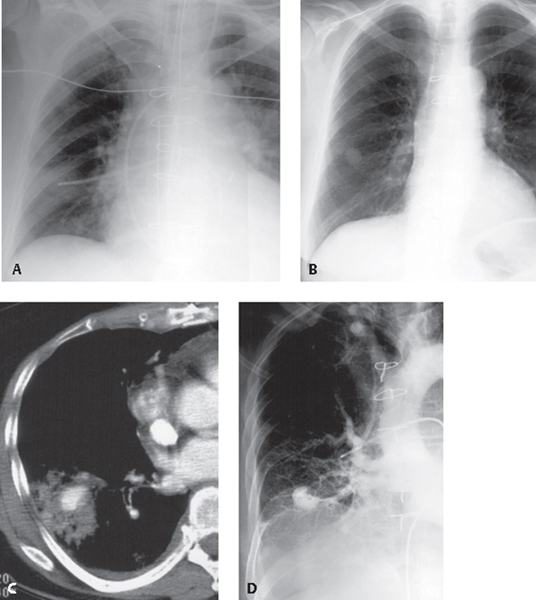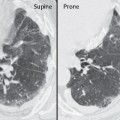CASE 149 66-year-old man who had undergone a remote coronary artery bypass was readmitted with chest pain and had a new pulmonary artery catheter placed Coned-down AP chest radiograph (Fig. 149.1A) demonstrates a pulmonary artery (Swan-Ganz) catheter extending into the right lower lobe pulmonary artery; its tip projects beyond the right mid-clavicular line and is surrounded by focal indistinct ground glass opacity. Follow-up coned-down PA chest radiograph one week later (Fig. 149.1B) shows a new nodular opacity at the site of the previous catheter tip. Contrast-enhanced chest CT (Fig. 149.1C) reveals a focal collection of contrast enhancement (pseudoaneurysm) in the right lower lobe surrounded by parenchymal consolidation. Coned-down AP radiograph (Fig. 149.1D) obtained during pulmonary angiography illustrates a pseudoaneurysm in a right lower lobe pulmonary artery conforming to the previously demonstrated abnormality on chest radiography and chest CT. Fig. 149.1 Pulmonary Artery Catheter-Related Vascular Pseudoaneurysm; Right Lower Lobe Pulmonary Artery • Acute Invasive Aspergillosis (nodule with halo sign) Pulmonary artery aneurysms and pseudoaneurysms are uncommon and may be related to previous trauma, including iatrogenic events from improper placement of Swan-Ganz catheters. Other causes include blunt trauma, Behçet disease, infection (mycotic pseudoaneurysm), and Hughes-Stovin syndrome (recurrent thrombophlebitis, pulmonary artery formation and rupture).
 Clinical Presentation
Clinical Presentation
 Radiologic Findings
Radiologic Findings

 Diagnosis
Diagnosis
 Differential Diagnosis
Differential Diagnosis
 Discussion
Discussion
Background
Stay updated, free articles. Join our Telegram channel

Full access? Get Clinical Tree






